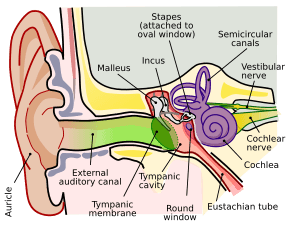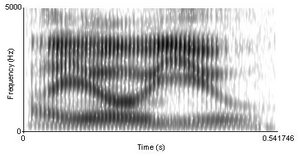Perception facts for kids
Perception is how your brain takes in information from your senses. It then organizes, identifies, and understands this information. This helps you make sense of the world around you.
Everything you perceive starts with signals. These signals travel through your nervous system. They come from your sensory system when it's touched by something physical or chemical. For example, when you see, light hits your retina. When you smell, tiny odor molecules are involved. When you hear, you are sensing pressure waves.
Perception is not just about receiving these signals. It's also shaped by what you've learned. Your memory, expectations, and attention all play a part.
Perception can be thought of in two main steps:
- First, your brain processes the sensory input. This turns simple information into more complex ideas. For example, it helps you recognize shapes to identify objects.
- Second, your brain uses your ideas and expectations. Things like attention also influence what you perceive.
Your nervous system does a lot of complicated work for perception. But it feels easy because it happens without you even thinking about it.
Scientists have learned a lot about perception over time. They use different methods to study it. For instance, Psychophysics measures how physical things relate to what you perceive. Sensory neuroscience looks at how your brain works during perception. Scientists also study perception by thinking about how information is processed.
People used to think our senses just passively received information. But studying illusions and ambiguous images shows something different. Your brain's perception system actively tries to understand what it's seeing. It does this even before you are consciously aware of it.
Your brain's perceptual systems help you see the world as steady. This is true even though the information your senses get is often incomplete. Human and animal brains are set up in a modular way. This means different parts of the brain handle different kinds of sensory information.
Some parts of the brain have "sensory maps." These maps show how parts of the world are represented in the brain. These different brain parts are connected and affect each other. For example, your sense of taste is greatly influenced by your sense of smell.
Contents
How We Perceive the World
Vision
Vision is a very important human sense. Light enters each eye and is focused onto the retina. The retina has many light-sensitive cells. These include rods, cones, and other special cells. They capture information about the light's brightness, color, and position.
Some processing of texture and movement happens right in the retina. Then, about 15 different types of information are sent to the brain. This travels through the optic nerve.
Sound
Hearing is your ability to sense sound by detecting vibrations. Humans can typically hear sounds between 20 Hz and 20,000 Hz. Sounds higher than this are called ultrasonic. Sounds lower than this are called infrasonic.
Your auditory system includes your outer ears. They collect and filter sound waves. Your middle ear changes sound pressure. Your inner ear then creates nerve signals from the sound. These signals travel to the primary auditory cortex in your brain. This is where sound information is processed further.
Sounds usually come from many places at once. Your brain has to work hard to separate these sounds. It also figures out how far away they are and where they are coming from.
Touch
Haptic perception is how you recognize objects using touch. It combines feeling patterns on your skin. These patterns can be edges, curves, or textures. It also uses proprioception, which is knowing your hand's position. People can quickly and accurately identify 3D objects by touch. This involves moving your fingers over the object or holding it. Haptic perception relies on the forces you feel when you touch something.
Scientists like Gibson said that the haptic system connects you to the world near your body. He and others stressed that touch and body movement are closely linked. Haptic perception is an active way of exploring.
Taste
Taste, or gustation, is your ability to sense the flavor of things, especially food. Humans taste through sensory organs called taste buds. These are mostly on the top of your tongue. Each human tongue has about ten thousand taste buds. Each bud has 100 to 150 taste receptor cells.
There are five main tastes: sweetness, bitterness, sourness, saltiness, and umami. Other tastes can be made by combining these basic ones. Umami is a newer taste discovery in Western cooking.
Basic tastes are only part of how food tastes. Other things include smell (from your nose), texture (from nerves in your mouth), and temperature. All basic tastes are either "appetitive" (good for you) or "aversive" (potentially harmful).
Smell
Smell is how you take in molecules through your nose. These molecules spread through a layer of mucus. They touch tiny hairs called cilia, which are on sensory neurons. Then, they are absorbed by one of about 347 different receptors. This process helps your brain understand smells.
Smell is also a very interactive sense. Scientists are finding that smell connects with other senses in surprising ways.
Smell is also considered a very basic sense. It might be the sense that helps with basic survival skills the most. It can be the first sign of safety or danger, or whether someone is a friend or foe. Smell can influence how humans act without them even knowing it.
Social Perception
Social perception is the part of perception that helps you understand other people and groups. It's a key part of how you think about social situations.
Speech
Speech perception is how you hear, understand, and interpret spoken languages. Scientists study how listeners recognize speech sounds. They also look at how this information helps us understand language.
The sound of a word can change a lot. It depends on the words around it and how fast someone is speaking. It also depends on the speaker's voice, accent, and mood. But listeners can still understand words even with all these differences. For example, your brain automatically adjusts for echoes in a room.
Understanding speech starts with the sound itself. Your brain compares the sound with visual information, like lip movements. This helps it get clues about the sounds. Other senses might also be used at this stage. This speech information then helps with higher-level language tasks, like recognizing words.
Images for kids
See also
 In Spanish: Percepción para niños
In Spanish: Percepción para niños






